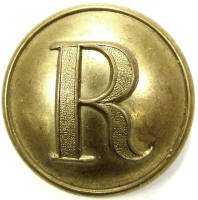
A virtual examination of artifacts of the American Civil War
 |
Ridgeway Civil War Research Center, A virtual examination of artifacts of the American Civil War |
| Civil War Artillery | |
| by Harry Ridgeway |
| Rifled artillery projectile, Sawyer design, Federal manufacture, bursting shell, lead sabot with lead sleeve, smooth sided, Sawyer combination fuze, Sawyer rifle, 3.67 in. Projectile was manufactured in the Federal arsenals, following the design of Addison M Sawyer. The sabot system was designed with a massive lead sabot covering the entire base and the sides. The design apparently proved unsatisfactory because the excessive lead consumed would gum up the bore on the cannon, and the elasticity of the lead probably lessened the dispersion of fragments, it was tested at Port Hudson, and then apparently abandoned. This pattern was cast without flanges, base is tapered, sides are smooth. Base is stamped "PATENTED NOVEMBER 13, 1855" and number "14 1/2" is stamped near the nose. Fuze employed was the Sawyer combination fuze, sometimes referred to as the "candlestick" fuze, Jones pg. 34. Sabot if fired will show six weak lands and grooves, a pattern unique to the Sawyer rifle. The massive lead sabot tended to soften or melt in firing, hence the rifling is usually obscured. Projectile measures: diameter 3.58in., length 7.6in., weight 15lbs. Research Center: Artillery5212-Sawyer, Ref: Dickey & George, Field Artillery (1993 Edition), pg. 295. Details click: http://relicman.com/artillery/Artillery5212-Sawyer.html. |
| Ridgeway Civil War Research Center, A virtual examination of artifacts of the American Civil War. Artillery Research center, artillery, click: http://relicman.com/artillery/Artillery0000-Index.html. Research center, artillery, click: http://relicman.com/artillery/Artillery0000-Index.html. |
| Civil War Relicman, Harry Ridgeway, Civil War artillery, Relicman sales catalog. Click here: http://relicman.com/artillery/RelicmanSalesArtillery1.html. Artillery for sale: http://relicman.com/artillery/RelicmanSalesArtillery1.html. |